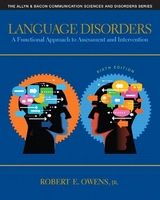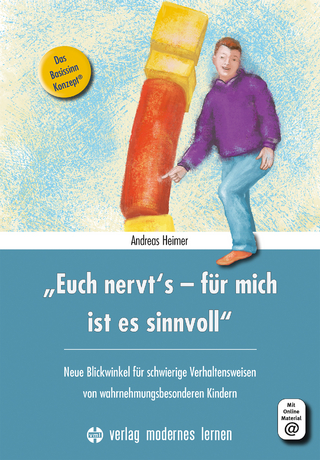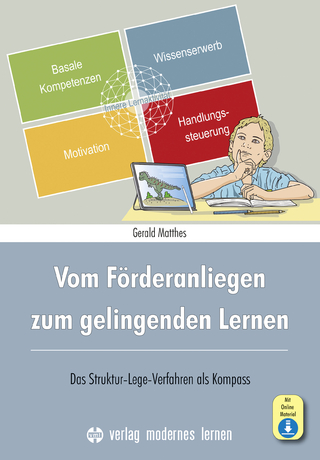
Language Disorders
Pearson (Verlag)
978-0-205-60764-8 (ISBN)
- Titel erscheint in neuer Auflage
- Artikel merken
The revised fifth edition is completely updated with current trends and developments in the field and offers an array of practical ideas and useful suggestions for students and speech-language pathologists. The text provides concrete guidelines and procedures for the assessment and training of children as well as training for speech-language pathologists.
Robert E. Owens, Jr., Ph.D., is a professor of speech-language pathology and director of the graduate program in speech pathology at the State University of New York at Geneseo. He is the author of a number of textbooks, book chapters, and articles, including Language Development: An Introduction (Allyn & Bacon, 2007), and the Program for Acquisition of Language with the Severely Impaired (PALS). He has presented approximately 150 professional papers and workshops in both the U.S. and abroad.
Language Disorders: A Functional Approach to Assessment and Intervention, 5/e
Preface ix
Part I: Introduction 1
1 A Functional Language Approach 3
Role of Pragmatics in Intervention 8
Dimensions of Communication Context Summary 10
Role of Generalization in Intervention 10
Variables that Affect Generalization Summary 17
Evidence-Based Practice 17
Conclusion 19
2 Language Impairments 21
Diagnostic Categories 22
Information Processing 24
Mental Retardation or Intellectual Diability 26
Language Learning Disability 34
Specific Language Impairment 41
Pervasive Developmental Disorder/Autism-Spectrum Disorder 48
Brain Injury 55
Maltreatment: Neglect or Abuse 57
Other Language Impairments 61
Conclusion 63
Implications 64
Part II: Communication Assessment 67
3 Assessment of Preschool and School-Age Children with Language Impairment 69
Psychometric Versus Descriptive Procedures 7
Psychometric Assessment Protocols 73
Test Differences 74
Content 74
Misuse of Normative Testing 75
Variables in Test Selection 79
Summary 80
Descriptive Approaches 80
Reliability and Validity 81
Summary 83
An Integrated Functional Assessment Strategy 83
Questionnaire, Interview, and Referral 84
Observation 85
Formal Testing 87
Sampling 97
Assessment for Information-Processing Deficits 98
Conclusion 98
4 Assessment of Preschool and School-Age Children with Language Difference 99
State of Service Delivery 101
Lack of Preparation and Experience 101
Unfamiliarity with Language and Culture 101
Lack of Appropriate Assessment Tools 106
Overcoming Bias in an Assessment 107
Use of Interpreters 108
Alternative Assessment 110
An Integrated Model for Assessment 111
Children with LEP 112
Children with Different Dialects 118
Summary 120
Conclusion 120
5 Language Sampling 121
Planning and Collecting a Representative Sample 122
Representativeness 122
A Variety of Language Contexts 123
Evocative Conversational Techniques 128
Language Sampling of Children with CLD Backgrounds 137
Recording the Sample 138
Transcribing the Sample 140
Collecting Samples of Written Language 143
Conclusion 143
6 Analysis Across Utterances and Partners and by Communication Event 145
Across Utterances and Partners 147
Stylistic Variations 147
Referential Communication 148
Cohesive Devices 151
Communication Event 153
Social Versus Nonsocial 154
Conversational Initiation 155
Topic Initiation 156
Conversation and Topic Maintenance 158
Duration of Topic 161
Topic Analysis Format 162
Turn Taking 166
Conversation and Topic Termination 169
Conversational Breakdown 170
Conversational Partner 173
Conclusion 175
7 Analyzing a Language Sample at the Utterance Level 176
Language Use 177
Disruptions 178
Intentions 179
Content 184
Lexical Items 185
Word Relationships 187
Figurative Language 190
Word Finding 191
Form 192
Quantitative Measures 192
Syntactic and Morphological Analysis 197
Conclusion 215
8 Narrative Analysis 216
Scripts and Narrative Frames 218
Collecting Narratives 218
Narrative Analysis 220
Narrative Levels 221
High-Point Analysis 222
Story Grammars 224
Expressive Elaboration 227
Quantitative Measures 229
Cohesive Devices 230
Reliability and Validity 232
Children with CLD Backgrounds 233
Narrative Collection and Analysis 235
Conclusion 236
Part 3 Intervention 239
9 A Functional Intervention Model 241
Principles 243
The Language Facilitator as Reinforcer 243
Close Approximation of Natural Learning 244
Following Developmental Guidelines 244
Following the Child’s Lead 246
Active Involvement of the Child 247
Heavy Influence of Context on Language 247
Familiar Events Providing Scripts 247
Designing a Generalization Plan First 248
Generalization Variables 248
Training Targets 248
Training Items 250
Method of Training 252
Language Facilitators 255
Training Cues 262
Contingencies 263
Location 264
Conclusion 265
10 Manipulating Context 266
Nonlinguistic Contexts 267
Linguistic Contexts 269
Modeling 270
Direct Linguistic Cues 272
Indirect Linguistic Cues 273
Contingencies 274
Top-Down Teaching 279
Conclusion 281
11 Specific Intervention Techniques 283
Pragmatics 283
Intentions 284
Conversational Abilities 288
Narration 295
Semantics 299
Inadequate Vocabulary 300
Semantic Categories and Relational Words 303
Word Retrieval and Categorization 311
Comprehension 315
Syntax and Morphology 322
Morphology 323
Verb Tensing 323
Pronouns 327
Plurals 328
Articles 328
Prepositions 329
Word Order and Sentence Types 330
Summary 331
Children with CLD Backgrounds 333
Use of Microcomputers 336
Conclusion 338
12 Classroom Functional Intervention 339
Background and Rationale: Recent Educational Changes 340
Inclusion 341
Collaborative Teaching 342
Summary 343
Role of the Speech-Language Pathologist 344
Relating to Others 344
Language Intervention and Language Arts 345
Elements of a Classroom Model 346
Identification of Children at Risk 346
Curriculum-Based Intervention 353
Linguistic Awareness Intervention Within the Classroom 358
Language Facilitation 365
Instituting a Classroom Model 370
Conclusion 374
13 Literacy Impairments: Language in a Visual Mode 375
Reading 377
Reading Problems 377
Children with CLD Backgrounds 379
Assessment of Reading 380
Intervention for Reading Impairment 385
Writing 397
Writing Problems 397
Assessment of Writing 399
Intervention for Writing Impairment 403
Conclusion 408
Appendices
A Considerations for CLD Children 409
B Language Analysis Methods 419
C Selected English Morphological Prefixes and Suffixes 443
D Indirect Elicitation Techniques 445
E Intervention Activities and Language Targets 449
F Use of Children’s Literature in Preschool Classrooms 453
Glossary 467
References 471
Author Index 535
Subject Index 549
| Erscheint lt. Verlag | 23.4.2009 |
|---|---|
| Sprache | englisch |
| Maße | 190 x 232 mm |
| Gewicht | 840 g |
| Themenwelt | Sozialwissenschaften ► Pädagogik ► Sonder-, Heil- und Förderpädagogik |
| ISBN-10 | 0-205-60764-0 / 0205607640 |
| ISBN-13 | 978-0-205-60764-8 / 9780205607648 |
| Zustand | Neuware |
| Haben Sie eine Frage zum Produkt? |
aus dem Bereich



